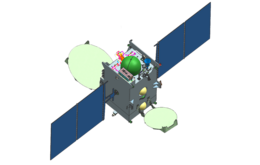 | |
| Names | GSAT-9 |
|---|---|
| Mission type | Communications / Meteorology |
| Operator | ISRO |
| COSPAR ID | 2017-024A |
| SATCAT no. | 42695 |
| Website | GSAT-9 |
| Mission duration | Planned: 12 years[1] Elapsed: 7 years, 6 months, 12 days |
| Spacecraft properties | |
| Bus | I-2K[1] |
| Manufacturer | ISRO Satellite Centre Space Applications Centre |
| Launch mass | 2,230 kg (4,916 lb)[1] |
| Dry mass | 976 kg (2,152 lb)[1] |
| Dimensions | 1.53 × 1.65 × 2.40 m (5.0 × 5.4 × 7.9 ft)[1] |
| Power | 3,500 watts[1] |
| Start of mission | |
| Launch date | 5 May 2017, 11:27 UTC[2] |
| Rocket | GSLV Mk II-F09[1] |
| Launch site | Satish Dhawan SLP |
| Contractor | ISRO |
| Orbital parameters | |
| Reference system | Geocentric |
| Regime | Geostationary |
| Longitude | 48° E |
| Perigee altitude | 35,769 km (22,226 mi) |
| Apogee altitude | 35,802 km (22,246 mi) |
| Inclination | 0.0413° |
| Epoch | 5 June 2017, 17:02:43 UTC[3] |
| Transponders | |
| Band | 12 × Ku band |
| Coverage area | SAARC |
The South Asia Satellite (designated GSAT-9), formerly known as SAARC Satellite, is a geostationary[4] communications and meteorology satellite operated by the Indian Space Research Organisation for the South Asian Association for Regional Cooperation (SAARC) region.[5] The satellite was launched on 5 May 2017. During the 18th SAARC summit held in Nepal in 2014, Indian Prime Minister Narendra Modi mooted the idea of a satellite serving the needs of SAARC member nations[6][7] as a part of his neighbourhood first policy.[8] Afghanistan, Bangladesh, Bhutan, Maldives, Nepal and Sri Lanka are the users of the multi-dimensional facilities provided by the satellite.
Pakistan "offered technical and monetary support"[9] which India rejected saying that it wanted the project to be a "gift" and multi-national collaboration would be time-consuming.[10] Pakistan later on declined to participate in the project citing India's refusal to collaboration and security reasons.[11][12] Afghanistan too was initially non-committal to the satellite[13] which led to renaming of satellite from "SAARC Satellite" to "South Asia Satellite" referring just to the subcontinent. As of 2019 with exception of Pakistan, the satellite is in service with all SAARC countries.
The South Asia Satellite provides crucial information on tele-medicine, tele-education, banking and television broadcasting opportunities. It is also equipped with remote sensing state of the art technology which enables collection of real-time weather data and helps in observations of the geology of the South Asian nations.[14]
- ^ a b c d e f g "GSLV-F09 / GSAT-9 Mission" (PDF). Indian Space Research Organisation. Archived from the original (PDF) on 31 July 2017. Retrieved 6 June 2017.
- ^ Richardson, Derek (5 May 2017). "India sends GSAT-9 into orbit atop GSLV". Spaceflight Insider. Retrieved 12 June 2017.
- ^ "GSAT-9 - Orbit". Heavens-Above. 5 June 2017. Retrieved 12 June 2017.
- ^ "GSAT-9". Indian Space Research Organisation. Archived from the original on 15 April 2021. Retrieved 29 May 2017.
- ^ "Isro-Saarc satellite to be a communication vehicle". Deccan Herald. Deccan Herald News Service. 12 January 2015. Retrieved 22 April 2015.
- ^ "Isro Says Saarc Satellite Configuration Will Be Finalised Soon". NDTV. Indo Asian News Service. 30 March 2015. Retrieved 22 April 2015.
- ^ "'Space diplomacy' in South Asia". BBC News. 1 July 2014. Retrieved 22 April 2015.
- ^ "India's SAARC satellite proposal: a boost to a multilateral space agenda". The Space Review. 18 August 2014. Retrieved 22 April 2015.
- ^ "India calls satellite 'gift to South Asia', Pakistan says no thanks". Dawn. 5 May 2017. Retrieved 30 September 2017.
- ^ Cite error: The named reference
Times of India, 2015was invoked but never defined (see the help page). - ^ "Pakistan raises security issues to oppose SAARC satellite project". The Economic Times. 26 January 2015.
- ^ "Soutg Asia Satellite (GSAT-9) launch: Pakistan blames India for "pull out" from project". The Financial Express. 6 May 2017.
- ^ "After Pakistan, Afghanistan shows no interest in PM Narendra Modi's satellite project". The Economic Times. Press Trust of India. 15 May 2016.
- ^ "SAARC Satellite Likely to be Launched Next Year, Pakistan Agrees to Participate". NDTV. Indo Asian News Service. 23 June 2015.